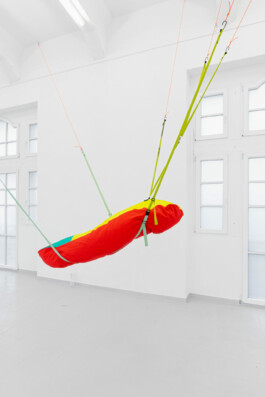Interview mit
Jasmin Schmidt
Jasmin Schmidt, Artist Talk
Within Jasmin Schmidt's artistic way of working the individual sources of inspiration that lead to a new work of art play a major role. As Harriet Zilch wrote about Jasmin's work in 2019: “An individual memory or association can also be a source of inspiration, as objects, photographs or terms that the artist collects in a personal archive: [for example] the slogan “old ideas upset”, was taken from a mattress advertisement promising restful sleep.”
In the following interview, Jasmin gave us an insight into her work and the process that leads her to a new work of art.
Jasmin studied painting at the Academy of Fine Arts in Nuremberg and was appointed a master class student by Prof. Thomas Hartmann. In addition to the Bavarian Culture Prize (2013), the Bavarian Art Prize for Fine Arts (2014), and the Nuremberg SI Art Prize (2019), her work was awarded the Art Prize of the City of Rastatt in 2020. She currently lives and works in Flossenbürg.
Tanja Heuchele: your life without art would be….
Jasmin Schmidt: … a different one.
TH: The working title of the exhibition is “Contingency and Painting”. What does contingency mean to you in your artistic practice?
JS: In my artistic practice, this term does not play a role as such. But it can be applied to certain decision-making processes in my work from the outside. My paintings reveal chains of decisions and their possible changes.
TH: Which places or situations were a source of inspiration for the exhibited works?
JS: As for many of my works, there are several elements that intertwine to set an image in motion. Mostly it is motifs from found objects or certain terms/words. These play only a partially recognisable role on the visual level until the end.
TH: To what extent have the current circumstances (last year and this year) influenced your way of working?
JS: The pandemic has not led to a general break in my work. What I consider problematic is the additional burden of caregiving tasks in the family environment, which have consequently limited my working time in the studio. The general uncertainty that has worked through me and all the people in my environment is certainly an aspect that is also reflected in my work, but not thematically in the foreground.
The Artist, Jasmin Schmidt

Jasmin Schmidt, Artist Talk
TH: Forms, structures, and patterns of objects and plants can be found again and again in your work. Do you actively search for motifs/objects that appeal to you, or do you come across them more by chance?
JS: I am interested in the things mentioned and this inevitably results in a mixture of active search and chance encounter. Because you see what you are looking for and recognise what it can be complemented with. Ornament is probably one of the oldest forms of non-figurative representation. It moves between representationalism and abstraction, between the opposite poles of organic and geometric, between decorative surface and symbolically condensed space. The ornament is always a balancing act between meaning and abstraction, between reference and hermeticism, and in this respect, it fits my search.
TH: When we look at your painting “old ideas upset”, what fixed idea brought you to it and what do you want to express with the work?
JS: “Fixed idea” is an inappropriate term in this context. As with all my works, there were several unifying elements that accompanied the process of creating the work. The slogan “old ideas upset”, from a 1950s mattress advertisement promising restful sleep, could be cited here as a concrete set piece. This sentence “got me” in terms of content because it reflects personal and social issues. The slogan in a fragmentary, not immediately decipherable script is built up from clear geometric elements, which in turn are arranged on many small pieces of canvas sewn together. In the process, painting and stitching meet, cancel each other out, run into each other. A visual and spatial intertwining.
Jasmin Schmidt, Exhibition View, 2021

Jasmin Schmidt, Artist Talk
TH: Even if it is not immediately obvious, you often use unconventional materials as support for your works. For example, you have already created paintings on the backs of old school maps. What role do the supports play in the works you showed in the exhibition?
JS: Picture supports are of great importance to me. I try to treat them as places on which, and through which, the painting takes shape and can take place. The painting is always created in interaction with this medium. The work “Citadel” was created from many strips of colourful loden fabric sewn together, which grew into an architectural form in a process of layered priming, not only in terms of motif, but also as a structured surface. The striped structure of the seams resulted in a restrained, graphic application of colour that allows individual building blocks to stand out.
TH: From your curriculum vitae it is clear that you first studied African culture and society. To what extent did these studies influence your artistic development?
JS: Through the examination of sociological and ethnological themes and the focus on contemporary African art, I acquired a good and fruitful basis that still influences my work today. I needed this time in academic study to orient myself and engage with society, both on a theoretical level and in dealing with cultural experiences gained during internships. The reflection on place and painting that informs my work is significantly influenced by these impressions.
Jasmin Schmidt, Exhibition View, 2021

Siehe auch
Mehr Interviews




